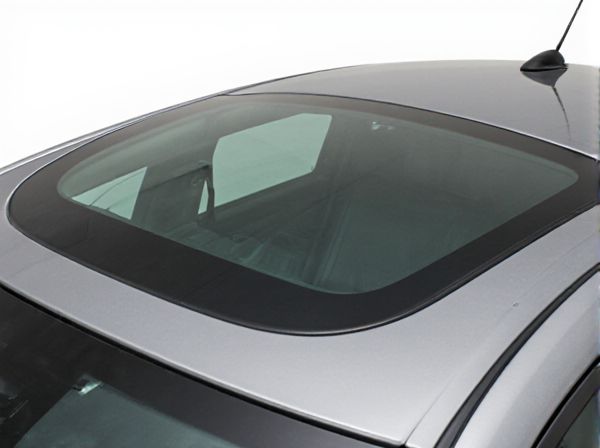
Photo illustration: Solid Roof vs Glass Roof
A solid roof offers superior insulation and privacy, making it ideal for year-round comfort and energy efficiency. Glass roofs provide abundant natural light and a seamless connection to the outdoors, enhancing the aesthetic appeal of your space. Your choice depends on whether you prioritize comfort and privacy or light and openness.
Table of Comparison
| Feature | Solid Roof | Glass Roof |
|---|---|---|
| Material | Metal or composite panel | Tempered or laminated glass |
| Light Transmission | Low - blocks sunlight | High - allows natural light |
| Heat Insulation | Better thermal insulation | Less insulation; may require tinting |
| Privacy | Complete privacy | Reduced privacy unless tinted |
| Weight | Heavier | Lighter |
| Durability | More impact resistant | More prone to cracks or chips |
| Maintenance | Low maintenance | Requires regular cleaning, special care |
| Cost | Generally lower cost | Typically higher cost |
Introduction to Solid Roofs and Glass Roofs
Solid roofs provide excellent insulation, durability, and privacy, making them ideal for year-round use and varying weather conditions. Glass roofs maximize natural light, create a bright and airy interior, and offer aesthetic appeal while requiring additional measures for temperature control and UV protection. Choosing between solid roofs and glass roofs depends on needs for thermal efficiency, light exposure, and design preferences.
Key Differences Between Solid and Glass Roofs
Solid roofs provide superior insulation, offering better temperature regulation and noise reduction compared to glass roofs, which typically allow for more natural light but less thermal efficiency. Glass roofs enhance aesthetic appeal and create brighter spaces by maximizing daylight exposure, whereas solid roofs prioritize privacy and durability. Maintenance demands differ as well, with glass roofs requiring frequent cleaning and inspections to avoid leaks, while solid roofs generally offer longer-lasting protection with minimal upkeep.
Benefits of Solid Roofs
Solid roofs provide superior insulation, significantly reducing energy costs by maintaining indoor temperatures more effectively than glass roofs. They offer enhanced privacy and noise reduction, creating a comfortable and quiet living environment. Durable materials used in solid roofs ensure long-lasting protection against weather elements, minimizing maintenance needs compared to glass roofs.
Advantages of Glass Roofs
Glass roofs offer superior natural light penetration, enhancing indoor brightness and reducing the need for artificial lighting. They provide panoramic views and a modern aesthetic that seamlessly connects indoor and outdoor spaces. Energy-efficient glass options can help regulate temperature, increasing comfort while minimizing energy costs.
Energy Efficiency Comparison
Solid roofs provide superior energy efficiency by offering better insulation, reducing heat loss during winter and minimizing heat gain in summer, which lowers heating and cooling costs. Glass roofs, although aesthetically appealing and great for natural light, often result in higher energy consumption due to poor thermal insulation and increased solar heat gain. Energy-efficient glazing options and advanced coatings can improve glass roof performance but typically do not match the insulation benefits of solid roofing materials.
Natural Lighting and Ambiance
Solid roofs provide superior insulation and privacy but limit natural lighting, creating a cozy and controlled ambiance ideal for all-season use. Glass roofs maximize sunlight exposure, enhancing brightness and openness while offering panoramic views, which fosters a vibrant and airy atmosphere. Choosing between a solid roof and a glass roof depends on the desired balance between natural light benefits and temperature regulation for the space.
Insulation and Noise Reduction
Solid roofs provide superior insulation and noise reduction compared to glass roofs due to their dense materials, which act as effective barriers against heat loss and external sounds. Glass roofs, although offering natural light, generally have poorer thermal insulation and allow more noise transmission unless double or triple glazing with specialized laminates is used. Choosing solid roofing materials enhances energy efficiency and creates a quieter indoor environment, making them ideal for areas requiring enhanced comfort and privacy.
Maintenance and Durability
Solid roofs offer superior durability with materials like tiles or metal that can withstand harsh weather and require minimal maintenance, typically involving occasional inspections and cleaning. Glass roofs demand more frequent upkeep to maintain transparency and prevent damage, including regular cleaning, resealing, and occasional glass panel replacements due to potential cracking or weathering. The lifespan of solid roofs generally exceeds that of glass roofs, making them a cost-effective choice for long-term durability and low maintenance.
Cost Considerations
Solid roofs typically cost less upfront compared to glass roofs due to cheaper materials like asphalt shingles or metal panels versus expensive tempered glass or polycarbonate panels. Installation costs for solid roofs are generally lower because they require less specialized labor and tools, whereas glass roofs demand precision fitting and sealing to prevent leaks and maintain insulation. Over time, maintenance expenses for glass roofs can be higher due to cleaning requirements and potential glass replacement, while solid roofs often incur lower upkeep costs with occasional inspections and repairs.
Which Roof Type Is Best for Your Home?
Solid roofs offer superior insulation and energy efficiency, making them ideal for homeowners prioritizing thermal comfort and noise reduction. Glass roofs maximize natural light and create a visually open atmosphere, perfect for spaces like conservatories and sunrooms where brightness is desired. Choosing between solid and glass roofs depends on factors such as climate, intended room use, and personal preferences for light versus insulation.
 caratoz.com
caratoz.com